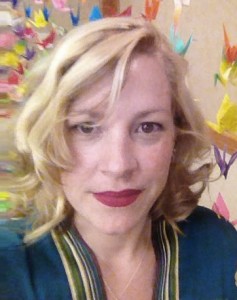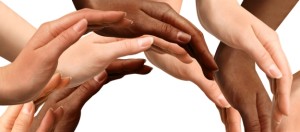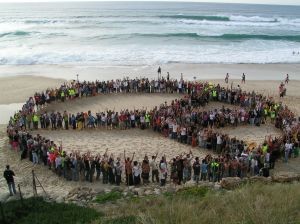Visiting Churches of Various Cultures: Reflections by Colette Casburn Numajiri (cont.)
The fifth church Colette Numajiri and I visited on our adventure of visiting churches of various cultures was a United Methodist Church in Dallas. This church is closer to “multicultural” than any of the churches we’ve visited so far. We were delighted to see African Americans, Africans, Indians, and Anglos worshiping together.
It was also exciting to see a strong African American woman as pastor of this church. The other four churches we’ve visited have male pastors.
But we were disappointed not to find inclusive language and imagery. Several of the other churches we’ve visited also used exclusively male language, but we didn’t notice it as much because only parts of the service were translated into English, and the Catholic church did have the female images of Mary.
So this visit brought mixed feelings: we celebrated the racial and cultural diversity and the powerful African American woman pastor, but we longed for inclusive language and imagery. We felt a dissonance between the exclusively male language and this racially inclusive congregation with a woman pastor.

Colette expresses her strong mixed feelings about this visit. Here are some excerpts from her reflections.
Outside the sanctuary, robe-clad people were waiting to process down the aisle. We found our spot in the middle of the pews, and the service began. The strong, beautiful African American pastor greeted everyone after the opening hymn.
It was wonderful to see more racial diversity than in other churches we’ve visited. The congregation was about 70% Anglo, 28% African American, and the rest African and Indian. The choir was not as diverse as the congregation, but sang a glorious anthem.
As the pastor began to read the announcements, I started to recall the Methodist churches I grew up in. Although I was very proud to be watching this great woman leader, I quickly grew tired of the “He, Him, He, Lord, Jesus, Kingdom, sin, blood. . . “ Every few words were masculine, and now that I know better, it was very hard to hear. We tried to change the words to “She, Her, and Sophia” wherever we could in the hymns and everywhere the church was asked to recite aloud. It was hard and strange. I felt like this church was in a time warp: that it was right after the witch hunts in England were over and the “men of God” had written these creeds, Lord’s prayer, and Doxology that told everyone what to think and say. I felt like a slave, having to repeat something so unnatural that immediately equated to my psyche that I was lesser and did not matter. I am the daughter of the daughters of Eve and evil and unholy. I just shake my head thinking about how in the world they convinced people to think this for 2000+ years!
But there She was though, before us as an eloquent and charismatic female pastor, leading us. Perhaps she had to use these chosen words to stay in that position and to have this work.
I’ve never seen anyone sing along to the hymns as joyfully as did an elderly white-haired man several rows in front of us. I would have too if the songs were about Godde being a woman! I don’t blame him at all; he lucked out being born an Anglo male because evidently that’s what God is.
What if, in this same beautiful church, with its gorgeous stained glass windows (of all male images unless that figure crying at the foot of the cross was female), this same wombish minister was up there telling us that we are all made in the image and likeness of the Divine and showing us through her language that we are ALL equal and perfect and special? What if? And when?
Perhaps it’s not fair to single out this church. What was I expecting? It was really eye-opening to re-experience this feeling of exclusion in church and to realize that most churches still use exclusively male language. Sadly, it seemed like brainwashing to me. And so many people have been victims of it, starting the first time their parents took them to church.
So, what do we do? I hope to do my part. Just by our visiting these churches, we are planting seeds.

 After the service, we stood in line to see the minister. When it was our turn to visit with her, Jann introduced us, saying we were from New Wineskins Feminist Ritual Community and doing research for a book on multicultural churches. The minister stepped back a bit, as though we were selling something. We didn’t know how she took us. And maybe we are saleswomen. Then if so, we’re selling freedom, peace, love, and acceptance for all.
After the service, we stood in line to see the minister. When it was our turn to visit with her, Jann introduced us, saying we were from New Wineskins Feminist Ritual Community and doing research for a book on multicultural churches. The minister stepped back a bit, as though we were selling something. We didn’t know how she took us. And maybe we are saleswomen. Then if so, we’re selling freedom, peace, love, and acceptance for all.



I am struggling with the “church” that has never felt inclusive. I found some semblance of what I was looking for in the UU church and became terribly disillusioned because it drew intellectuals primarily needing a ground to banter. It had not been my first experience as to why I overstayed my welcome. I was enthralled by a woman minister who has since retired, but remember what pulled me into the fold, even though very few people looked like me.
The prayer was God of many names and mystery beyond our understanding. It went on to include us all and I sat quietly and wept like I was among loved ones and no one had to no my name. To meet a God with no name, gender, and acknowlegement of the mystery felt like coming in out of the rain. I eventually left in a middle of a torrential storm and vowed that I could not return. It no longer was a safe haven, it felt more like confusion than mystery, it became more patriachal and decidely the needs of this congregant felt like a begged where there were none. My experience was the first time I felt traumatized by the church. I had been very careful my ENTIRE life, visited many denominations at least once, but I knew immediately with their was absolutely no connection and simply did not return. I could not identify at all with exclusiveness of any kind and choose not to be apart of church communities who do. What’s ironic they always say everyone is welcomed and it is simply not true.
I am driven by my heart and I listen with my head and I wonder will I ever find that place that feels like home, where I may serve and be served. Where I may not be an anomaly but a parishioner who feels safe as a woman of color, and that I truly feel that I am made in God’s image and it is simply acceptable. I want to be the bridge for passerby who feel left out of the church , as well as the water underneath that helps carry us to safety if we should fall off that bridge.
That is why I think the work that Colette and Jann are doing is so important, visting churches, fellowshipping, bringing in the messages that she lives and has always lived, we just did not always have brave storytellers to tell us about the divine being the mother, we lacked women to tell us the story of God in all her wisdom and mystery lives in us all.
Namaste
Pleas forgive the grammatical errors, just was in a rush about reading and responding to the post. I pledge to be in less haste and maybe use the computer for a better visual field.
I enjoyed the post very much and I think the research will be a very important and necessary spiritual map for those of us still looking to be a part of a church community that meets very important needs.
Thank you Colette and Jann for being navigators in this extremely important journey.
Many Blessings
Gwen ?
Thank you so much for writing your experiences of struggling with the “church.” We understand, and hope you’ll come visit New Wineskins Feminist Ritual Community. You’ll find information about this Community on this website.
All Blessings!
Jann